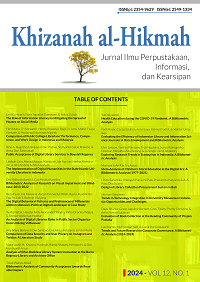Trends in Technology Integration in University Museums in Indonesia: Opportunities and Challenges
Abstract
This research aims to explore technology integration within university museums in Indonesia, focusing on preserving original artifacts while leveraging technological advancements. Adopting a qualitative approach, the study conducted in-depth interviews and open-ended questionnaires at six university museums across Indonesia. The findings reveal that university museums in Indonesia generally possess valuable collections of original artifacts that require preservation. Technology is crucial in supporting the museums' business processes, enhancing preservation and visitor engagement. Museum managers are driven to develop their institutions by seizing various opportunities presented by technological advancements despite facing several challenges. This study underscores the importance of technology in the evolution of university museums in Indonesia, highlighting the proactive measures taken by museum managers to overcome obstacles and achieve their development targets.
Downloads
References
Arriaga, A., & Aguirre, I. (2020). Museum-university collaboration to renew mediation in art and historical heritage. The case of the Museo de Navarra. Arte, Individuo y Sociedad, 32(4), 989–1008. https://doi.org/10.5209/aris.66295
Elkadi, H., Al-Maiyah, S., Fielder, K., Kenawy, I., & Martinson, D. B. (2021). The regulations and reality of indoor environmental standards for objects and visitors in museums. Renewable and Sustainable Energy Reviews, 152, 111653. https://doi.org/10.1016/j.rser.2021.111653
Escribano-Miralles, A., Serrano-Pastor, F.-J., & Miralles-Martínez, P. (2021). Perceptions of Educational Agents Regarding the Use of School Visits to Museums for the Teaching of History. Sustainability, 13(9), 4915. https://doi.org/10.3390/su13094915
Fontanella, F., Colace, F., Molinara, M., Scotto Di Freca, A., & Stanco, F. (2020). Pattern recognition and artificial intelligence techniques for cultural heritage. Pattern Recognition Letters, 138, 23–29. https://doi.org/10.1016/j.patrec.2020.06.018
Geladaki, S., & Papadimitriou, G. (2014). University Museums as Spaces of Education: The Case of the History of Education Museum at the University of Athens. Procedia - Social and Behavioral Sciences, 147, 300–306. https://doi.org/10.1016/j.sbspro.2014.07.174
Govekar Okoliš, M. (2022). University Students’ Views on the Efficacy of a Museum’s Historical School Lessons – The Case of Ancient Emona. Revija Za Elementarno Izobraževanje, 15(Spec. Iss.), 41–58. https://doi.org/10.18690/rei.15.Spec.Iss.41-58.2022
Innocente, C., Ulrich, L., Moos, S., & Vezzetti, E. (2023). A framework study on the use of immersive XR technologies in the cultural heritage domain. Journal of Cultural Heritage, 62, 268–283. https://doi.org/10.1016/j.culher.2023.06.001
Jacobs, J., & Porter, B. W. (2021). Repatriation in university museum collections: Case studies from the Phoebe A. Hearst Museum of Anthropology. International Journal of Cultural Property, 28(4), 531–550. https://doi.org/10.1017/S0940739121000400
Kissel, B., Miller, E., Byker, E., Good, A., & Fitchett, P. (2019). Museums as Mentor Texts: Preservice Teachers Analyze Informational Text Structures and Features Present in a Historical Museum. The Journal of Social Studies Research, 43(4), 343–360. https://doi.org/10.1016/j.jssr.2019.01.001
La Russa, F. M., & Santagati, C. (2021). An AI-based DSS for preventive conservation of museum collections in historic buildings. Journal of Archaeological Science: Reports, 35, 102735. https://doi.org/10.1016/j.jasrep.2020.102735
Li, Y. (2020). Art and Technology Exhibition under the Context of Artificial Intelligence. IFAC-PapersOnLine, 53(5), 103–105. https://doi.org/10.1016/j.ifacol.2021.04.087
Monteagudo-Fernández, J., Gómez-Carrasco, C. J., & Chaparro-Sainz, Á. (2021). Heritage Education and Research in Museums. Conceptual, Intellectual and Social Structure within a Knowledge Domain (2000–2019). Sustainability, 13(12), 6667. https://doi.org/10.3390/su13126667
Muravska, S., & Stasiuk, I. (2020). University heritage as an instrument for the development of the university brand. Museologica Brunensia, 2, 2–9. https://doi.org/10.5817/MuB2020-2-1
Noy, S., & Hancock, M. (2021). Teaching International Development Locally: Using Museum Collections to Ground Students’ Learning. Teaching Sociology, 49(1), 32–44. https://doi.org/10.1177/0092055X20966719
Paolanti, M., Pierdicca, R., Pietrini, R., Martini, M., & Frontoni, E. (2022). SeSAME: Re-identification-based ambient intelligence system for museum environment. Pattern Recognition Letters, 161, 17–23. https://doi.org/10.1016/j.patrec.2022.07.011
Pérez-Hernández, E., Peña-Alonso, C., & Hernández-Calvento, L. (2020). Assessing lost cultural heritage. A case study of the eastern coast of Las Palmas de Gran Canaria city (Spain). Land Use Policy, 96, 104697. https://doi.org/10.1016/j.landusepol.2020.104697
Poce, A., Amenduni, F., De Medio, C., Valente, M., & Re, M. R. (2019). Adopting Augmented Reality to Engage Higher Education Students in a Museum University Collection: The Experience at Roma Tre University. Information, 10(12), 373. https://doi.org/10.3390/info10120373
Schaper, M.-M., Santos, M., Malinverni, L., Zerbini Berro, J., & Pares, N. (2018). Learning about the past through situatedness, embodied exploration and digital augmentation of cultural heritage sites. International Journal of Human-Computer Studies, 114, 36–50. https://doi.org/10.1016/j.ijhcs.2018.01.003
Sharif-Askari, H., & Abu-Hijleh, B. (2018). Review of museums’ indoor environment conditions studies and guidelines and their impact on the museums’ artifacts and energy consumption. Building and Environment, 143, 186–195. https://doi.org/10.1016/j.buildenv.2018.07.012
Surin, D. (2018). Visual-graphic complex of museum as structural subdivision of university. IOP Conference Series: Materials Science and Engineering, 451, 012128. https://doi.org/10.1088/1757-899X/451/1/012128
Teichert, T., Sun, H., & González-Martel, C. (2021). Sequence effects of city tour experiences: A tourism fatigue perspective. Journal of Destination Marketing & Management, 21, 100646. https://doi.org/10.1016/j.jdmm.2021.100646
Trunfio, M., Jung, T., & Campana, S. (2022). Mixed reality experiences in museums: Exploring the impact of functional elements of the devices on visitors’ immersive experiences and post-experience behaviours. Information & Management, 59(8), 103698. https://doi.org/10.1016/j.im.2022.103698
Turan, B., & Keser, H. (2014). Museum Guide Mobile App: The Case of the Near East University Classical Car Museum. Procedia - Social and Behavioral Sciences, 131, 278–285. https://doi.org/10.1016/j.sbspro.2014.04.117
Yun, J. J., Choi, B., & Kim, J. (2021a). Changes and Challenges in Museum Management after the COVID-19 Pandemic. Journal of Open Innovation: Technology, Market, and Complexity, 7(2), 148. https://doi.org/10.3390/joitmc7020148
Yun, J. J., Choi, B., & Kim, J. (2021b). Changes and Challenges in Museum Management after the COVID-19 Pandemic. Journal of Open Innovation: Technology, Market, and Complexity, 7(2), 148. https://doi.org/10.3390/joitmc7020148
Zhao, W., Su, L., & Dou, F. (2023). Designing virtual reality based 3D modeling and interaction technologies for museums. Heliyon, 9(6), e16486. https://doi.org/10.1016/j.heliyon.2023.e16486
Copyright (c) 2024 Herman Setyawan

This work is licensed under a Creative Commons Attribution-NonCommercial-ShareAlike 4.0 International License.
By submitting your manuscript to our journal, you are following Copyright and License

